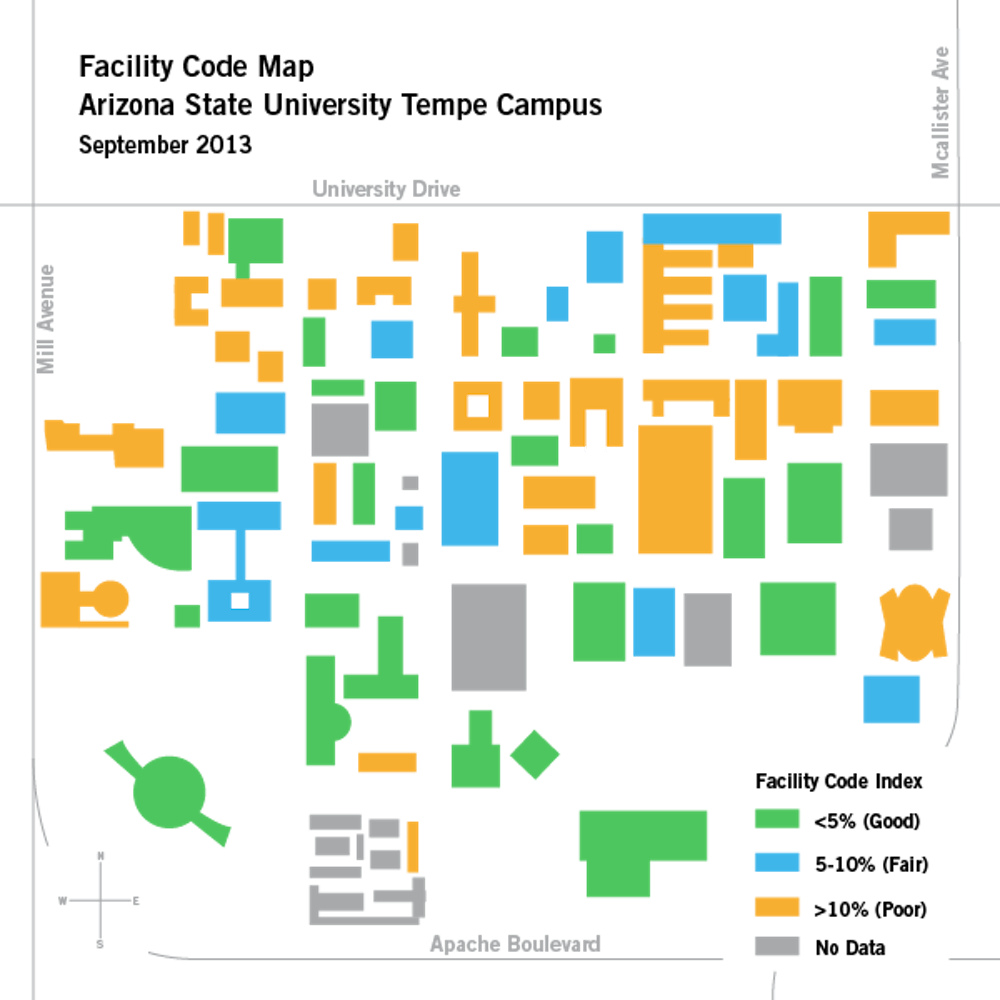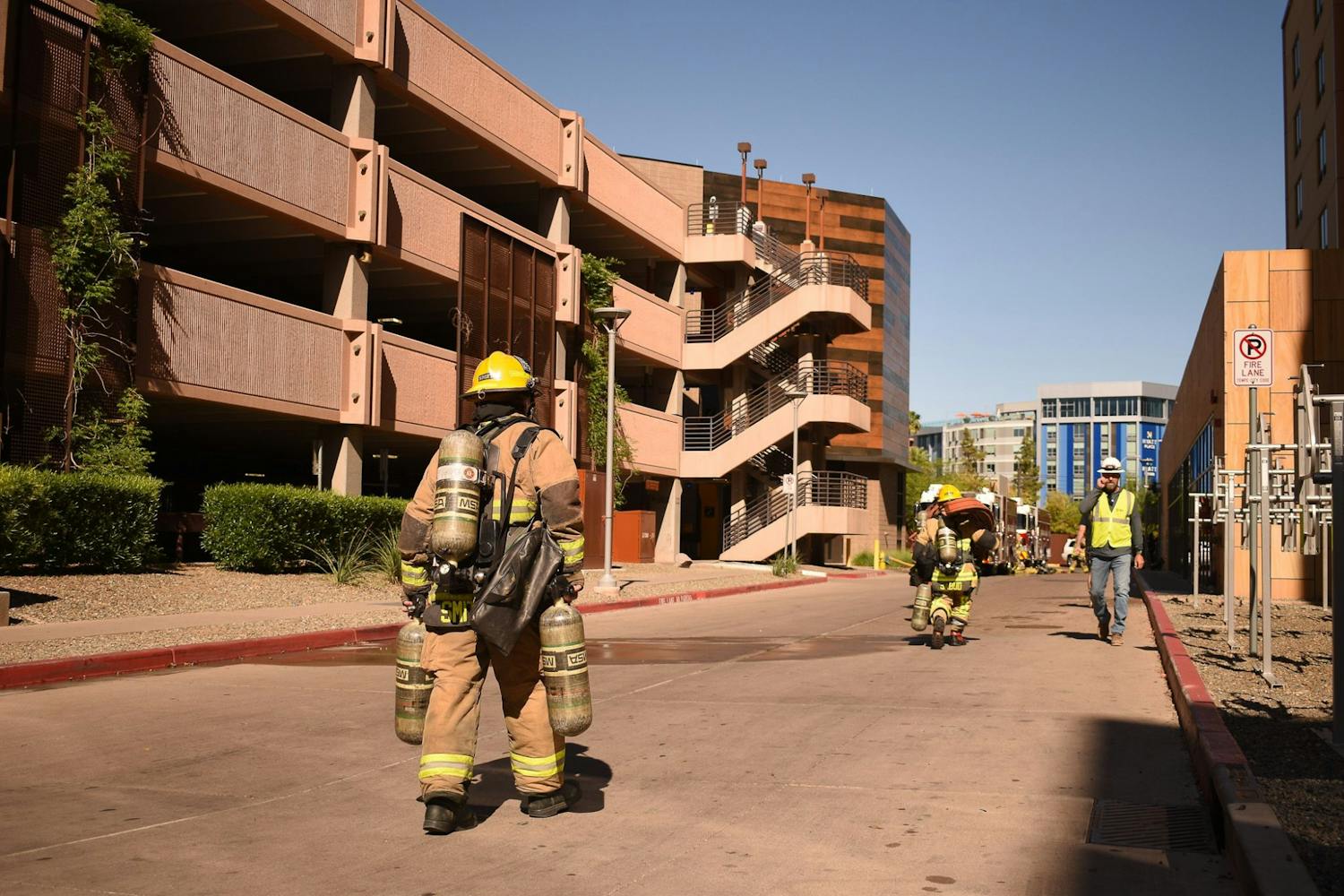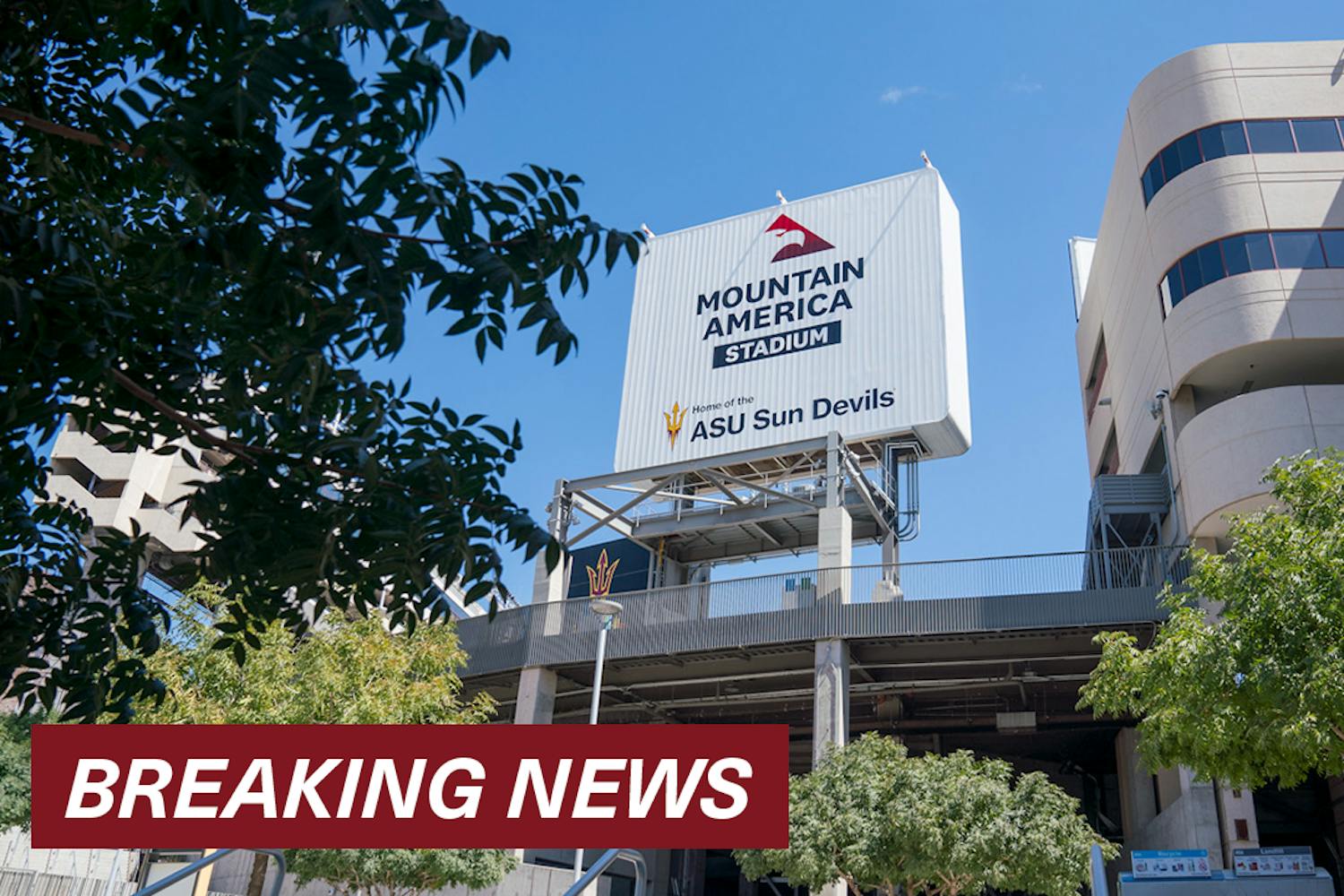 Roofing Supervisor Bob Bockas and Director of Facilities Management Clint Lord survey the roof of Armstrong Hall. The roof is near the end of its life and will cost $1 million to replace. (Photo by Alexis Macklin)
Roofing Supervisor Bob Bockas and Director of Facilities Management Clint Lord survey the roof of Armstrong Hall. The roof is near the end of its life and will cost $1 million to replace. (Photo by Alexis Macklin)The white-hot summer sun blazed on the bleached roof of Armstrong Hall, creating a pale backdrop for the silhouettes of the three men standing on it. They looked down over the Tempe campus with wary eyes, watching over their domain.
The men are members of ASU’s maintenance staff, who are doing their best to keep up more than 8 million gross square feet of aging campus buildings, while receiving almost no money from the state to do so.
As they walked across the roof and discussed the status of various structures, the roof squished down like a sponge beneath their feet — a sign that the roof is at the end of its life. It will cost around $1 million to replace.
Bruce Jensen, the Interim Associate Vice President for Facilities Development and Management, was among the men on the roof. After working at ASU for 13 years, he is in a constant state of worry for the University he is charged with maintaining, he said.
“(Worry) is a way of life,” he said. “That’s what we do.”
An Uphill Battle
So far in 2014, there have been three major power outages because of water leaks on the Tempe campus. But the problem existed long before this year.The Arizona Constitution requires the state to fund “proper maintenance” of state educational facilities, and so by law, the universities are required to submit requests to the state government for maintenance funding. The universities use a formula that takes into account the size, age and other factors of the buildings to compute a number for the request.
The state then allocates the money in the amount the government chooses to help fund the universities’ maintenance. All projects left unfunded are put off until more money is available and are referenced as being “deferred.”
For all three of Arizona’s public universities, the price tag of deferred maintenance for fiscal year 2015 totals over half a billion dollars.
Video by Sean Logan | Multimedia Director
This is because the vast majority of the universities’ requests have been deferred, creating a growing backlog as the schools continue to age. The formula has only been completely satisfied once, in fiscal 1999. Since then, the schools have gone long stretches without any funding at all for deferred maintenance. After seven years of no funding, the state granted $3 million for fiscal 2015’s maintenance, or less than 3 percent of the requested $107.5 million.
Willem Vermaas, a professor who teaches biotechnology courses in ASU’s Life Sciences E Wing, said water leaking from the pipes on the building’s upper floors has created a day-to-day issue for his classes and research.
“It affects everything," he said. "Everything gets wet, so you have to make sure your paperwork is put away and any equipment that might be shorted out gets out of the way,” he said. “Every year, you have an incident when you walk into the office and everything is wet, or you walk into a lab and stuff is dripping from the ceiling. … It would be so much easier if we didn’t have those leaks.”
Deferred maintenance isn’t just about the buildings it involves, but also the universities’ ability to perform academically and attract new students.
According to a 2006 study by APPA, a national group of educational facilities leadership professionals, more than 16 percent of prospective students said they rejected a college or university because of poorly kept facilities.
 Maintenance workers wrote on walls to communicate about equipment failure in the 1980s. Now every problem is reported immediately. (Photo by Alexis Macklin)
Maintenance workers wrote on walls to communicate about equipment failure in the 1980s. Now every problem is reported immediately. (Photo by Alexis Macklin)Here, There, Everywhere
Although ASU’s deferred maintenance costs are the highest of the three universities, at $242 million, it is not the only school struggling to keep up its facilities.
Christopher Kopach is the Assistant Vice President of Facilities Management at UA, which is facing over $160 million in deferred maintenance.
Kopach said UA’s oldest buildings and systems demand the most attention when it comes to immediate maintenance needs.
“We have a number of old buildings," he said. "Some are over 100 years old and those create some unique challenges. “Our (maintenance) tunnels are from the 1930s and need major repairs. We’ve overhauled sewer lines, so systematically we’re addressing those as funds are available.”
As a member of APPA, Kopach said he’s seen first-hand how schools across the nation are struggling to keep up as maintenance funds shrink or disappear.
“I think we all are under the challenge of the lack of deferred maintenance dollars and this is a challenge universities from across the country have,” he said. “You can only stretch the dollar so far.”
Arizona’s maintenance struggles only reflect a nationwide issue as states cope with less revenue after the economic recession.
The University of California, a 10-campus university system, has approximately $3.25 billion in deferred capital renewal, according to a page on its website.
UC spokesperson Dianne Klein said the California Department of Finance approached the university system earlier this year with the possibility of funding $50 million in maintenance projects, but the odds of this still happening look slim.
She said the nation’s priorities regarding higher education funding are misguided.
“The more so-called ‘urgent’ things, and I say that in quotes, are tuition and enrollment and things like that,” Klein said. "So the deferred maintenance is stretching and stretching, and the legislators keep putting it off because the roofs haven’t come down yet, really.”
At this point, it seems the only thing that could change legislators’ mind is a disaster, she said.
“There could be an earthquake at any time,” Klein said. “I hope it doesn't come down to a catastrophe happening for us to get wise too late, because this is an immediate need and we have to act before it’s too late.”
 The old phone boards in the basement of the Physical Sciences D building need replacement. ASU has $242 million in deferred maintenance costs. (Photo by Alexis Macklin)
The old phone boards in the basement of the Physical Sciences D building need replacement. ASU has $242 million in deferred maintenance costs. (Photo by Alexis Macklin)Still Waiting
Before climbing on the roof of Armstrong Hall, Bruce Jensen made stops at several mechanical rooms. These house all the major cooling, electrical and water systems that keep the buildings operational.
Below the Physical Sciences D building, Jensen looked at the rusty pipes and ancient equipment that bring him his daily worries. Then, he was called over by his colleague Clint Lord, the Director of Facilities Management.
“I’ve got a lot of water on the ground,” Lord said, motioning to the pool forming under the cooling unit. The trays designed to catch the water likely rusted away.
He dialed his phone and waited for someone else in the department to answer so he could report the problem.
Just as Lord and Jensen waited for their colleagues to respond, they also wait for funds to come through from the Legislature, while the state too waits for the economy to recover enough to grant more money to the universities.
The Chairman of the House Appropriations Committee, John Kavanagh, R-Fountain Hills, said the state government is still playing a waiting game when it comes to prioritizing deferred maintenance.
“Unfortunately we are still waiting for the economy to come back,” he said. “It is sputtering. … It could be a while before we get back to normal, assuming that this isn’t the new normal, which I hope is not the case.”
July was the fourth consecutive month this year that failed the meet the budget projection in terms of state revenue generated, according to a legislative report. Since June 2013, the state’s coincident index, which measures the state’s economic health by combining factors such as unemployment rates and wages, has only increased by 1.8 percent, while the national index increased by 3.2 percent.
Kavanagh said he fears without an increase in taxes, the shortfall could amount to nearly a billion dollars in the next few years.
But putting off the universities’ maintenance has an economic cost that contradicts the state’s effort to save money while doing so. ASU’s 2014 Legislative Briefing stated the cost of waiting to repair facilities can multiply up to 15 times the original repair cost, as the buildings’ issues are often exacerbated over time.
Kavanagh said the Legislature is aware of this fact, but is still unable to act because of shortfalls.
“Quite frankly, tell that to a starving family that needs their roof fixed,” he said. “Are they going to buy food or are they going to fix their roof? That’s the dilemma that we’re in. We know these things, but there are just higher priorities, like public safety, that are competing for limited funds.”
 In the basement of Physical Sciences D on the Tempe Campus, water leaks onto
In the basement of Physical Sciences D on the Tempe Campus, water leaks ontothe floor. Jensen said the flooding was most likely due to the rain. (Photo by Alexis
Macklin)
With a lack of funding for deferred maintenance and a growing need for repairs, the universities have had to look elsewhere.
They sell municipal bonds, which are attractive to investors because the interest paid on them is exempt from federal taxation, to pay for repairs. However, all bonds must be repaid, which means the universities must keep looking for a long-term solution.
Morgan Olsen, ASU’s executive vice president, treasurer and chief financial officer, held similar positions at Purdue University before coming to ASU. During his time there, Purdue faced an even worse deferred maintenance issue than ASU’s current dilemma, he said. Purdue created a new student fee to ease the problem.
Olsen said doing the same at ASU is always a possibility.
“We are absolutely aware of the impact on students and their parents who are helping them pay for a college education that it’s not without an impact,” he said. “That’s always part of the evaluation. That said, if it’s not coming form the allocation of state investments, then you have to look other places.”
Olsen said gifts to the University as well as current tuition revenues could also be designated for deferred maintenance, though these sources likely won’t be enough.
He also said the key to the University’s plan, until alternative funding can be generated, is prioritizing what needs to be fixed first. Safety is always the first priority, which is then followed by the most dire situations, such as leaks that threaten expensive equipment.
“There’s a very careful fiscal evaluation that goes into these decisions, we prioritize safety above everything else, so next would be preserving the University’s ability to realize its mission,” he said. "People are hard at work to fix the larger problem in the meantime, and there are some pretty good eyes kept on the higher priority.”
One of these people at work is Eileen Klein, president of the Arizona Board of Regents, the governing board for all three of the state’s public universities.
She said she does not expect to see significant contributions from the state in the near future for deferred maintenance and this realization has prompted her to act.
“We’ve been discussing, the university presidents and I, different proposals so we can figure out how to create more flexibility for the universities so they have the funding capacity they need, not just to maintain the buildings they have, but also to contract new buildings to accommodate our growth and to move forward with the research goals we set forth with the regents.”
These research goals refer to ABOR’s “2020 Vision,” which sets forth that Arizona’s universities will double their research capabilities by 2020.
Klein said because these discussions have only been preliminary, she is not ready to disclose their specifics. But simply waiting for the economy to recover isn’t a viable strategy to meet the regents’ goals or keep the universities competitive, she said.
“We can’t just wait for things to get better,” she said. “We have to find new ways and that requires us to think very differently about our entire financial model… We’re meeting with business groups and others about this very issue: How do we build capacity for our universities so we can meet the needs of students, increase the number of graduates and double our research capacity. These are really big issues, and it’s exciting to think about all of these things.”
The universities are also changing their relationship with the state, such as with their new general funding approach, Klein said.
After many discussions and planning, this will be the first year the state is requiring the universities to submit their budget request based on performance rather than raw student numbers.
 Water leaks underneath a potable water pipe in the basement of the Engineering Research Center. (Photo by Alexis Macklin)
Water leaks underneath a potable water pipe in the basement of the Engineering Research Center. (Photo by Alexis Macklin)Klein said she’s excited for the shift, as it will showcase the universities’ economic value as well as motivate them even more to succeed.
“We needed to make a better case to the policymakers of the universities’ contribution to our economy,” she said. “We need to make sure we’re graduating enough students to meet the needs of the economy and increasing research is also crucial to economic development. These things became the focus of an idea to have university funding based on university performance. … This has been a complete revamp and renaissance for our university system.”
Whether the solution is raising student fees or changing the state’s financial view of the universities, until change is made, Bruce Jensen and the rest of ASU’s maintenance staff will continue their struggles to maintain the University’s faltering equipment.
The job is always stressful, but it’s not fruitless, Jensen said.
“We run from one event to another,” he said. “We do the best we can with what we have. But our efforts, our concerns, what drives us is the students and that learning environment. Yes, it’s kind of tense, but when we see the students, enjoying themselves in the learning environment (and) gaining from that, that’s the reward that we get.”
The scorching sun continues to shine while Jensen and Lord drive in their ASU cart to different building sites. The two men seem to deal with their stress with humor, as they both joke and laugh throughout the winding drive.
Even the University’s dismal chances of receiving adequate funding for deferred maintenance isn’t too dark to become a joke.
“I play the Powerball every so often, and I bet the odds are just the same!” Lord said with a grin.
Jensen laughed heartily and said, “At least somebody’s gotta win!”
Reach the reporter at elmahone@asu.edu or follow her on Twitter @mahoneysthename







